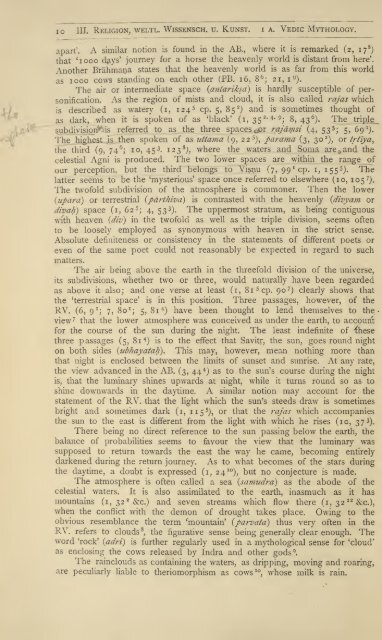You also want an ePaper? Increase the reach of your titles
YUMPU automatically turns print PDFs into web optimized ePapers that Google loves.
io III. RELIGION, WELTL. WISSENSCH. u. KUNST. i A. VEDIC MYTHOLOGY.<br />
apart . A<br />
similar notion is found in the AB., where it is remarked (2, iy 8<br />
)<br />
that 1000 days journey for a horse the heavenly<br />
world is distant from here .<br />
Another Brahmana states that the heavenly world is as far from this world<br />
as 1000 cows standing on each other (PB. 16, 8 6<br />
; 21, i 9).<br />
The air or intermediate space (antariksd) is hardly susceptible of per<br />
sonification. As the region of mists and cloud, it is also called rajas which<br />
5<br />
is described as watery (i, i24 cp. 5, 85 2<br />
j and is sometimes thought of<br />
as dark, when it is spoken of as black 2&gt;4 9 6<br />
(i, 35<br />
; 8, 43 ). The triple<br />
subdivision is referred to as the three spaces ^or rajdmsi (4, 53 5 ; 5, 69 x<br />
).<br />
The highest is then spoken of as uttama 5<br />
(9, 22 j, parama (3, 30 2<br />
), or trtlya,<br />
the third (9, 74 6<br />
; io, 45 3 . I23 8<br />
;, where the waters and Soma are _&gt; and<br />
the<br />
celestial Agni is produced. The two lower spaces are within the range of<br />
our perception, but the third belongs to Visnu (7, 99 r<br />
cp. i, i55 5 ). The<br />
latter seems to be the mysterious space once referred to elsewhere (io, io5 7 ).<br />
The twofold subdivision of the atmosphere is commoner. Then the lower<br />
(upard) or terrestrial (parthiva) is contrasted with the heavenly (divyam or<br />
divah) space (i, 62 s ; 4, 53 3 ). The uppermost stratum, as being contiguous<br />
with heaven (div) in the twofold as well as the triple division, seems often<br />
to be loosely employed as synonymous with heaven in the strict sense.<br />
Absolute definiteness or consistency in the statements of different poets or<br />
even of the same poet could not reasonably be expected in regard to such<br />
matters.<br />
The air being above the earth in the threefold division of the universe,<br />
its subdivisions, whether two or three, would naturally have been regarded<br />
shows that<br />
as above it also; and one verse at least (i, 8i 5<br />
cp. 90 7 ) clearly<br />
the terrestrial space is in this position. Three passages, however, of the<br />
RV. (6,<br />
1<br />
9 ; 7, So 1<br />
; 5, 8i 4 ) have been thought to lend themselves to the -<br />
view 7 that the lower atmosphere was conceived as under the earth, to account<br />
for the course of the sun during the night. The least indefinite of fhese<br />
three passages (5, 8i 4 ) is to the effect that Savitr, the sun, goes round night<br />
on both sides (ubhayatah). This may, however, mean nothing more than<br />
that night is enclosed between the limits of sunset and sunrise. At any rate,<br />
the view advanced in the AB. (3, 44 *) as to the sun s course during the night<br />
is, that the luminary shines upwards at night, while it turns round so as to<br />
shine downwards in the daytime. A similar notion may account for the<br />
statement of the RV. that the light which the sun s steeds draw is sometimes<br />
bright and sometimes dark (i, H5 5 ), or that the rajas which accompanies<br />
the sun to the east is different from the light with which he rises (io, 37 3 ).<br />
There being no direct reference to the sun passing below the earth, the<br />
balance of probabilities seems to favour the view that the luminary was<br />
supposed to return towards the east the way he came, becoming entirely<br />
darkened during the return journey. As to what becomes of the stars during<br />
the daytime, a doubt is expressed (i, 24), but no conjecture is made.<br />
The atmosphere is often called a sea (samudra) as the abode of the<br />
celestial waters. It is also assimilated to the earth, inasmuch as it has<br />
2<br />
mountains 12<br />
(i, 32 &c.) and seven streams which flow there (i, 32 &c.),<br />
when the conflict with the demon of drought takes place. Owing to the<br />
obvious resemblance the term mountain (parvata) thus very often in the<br />
RV. refers to clouds 8<br />
, the figurative sense being generally clear enough. The<br />
word rock (adri) is further regularly used in a mythological sense for cloud<br />
as enclosing the cows released by Indra and other gods 9 .<br />
The rainclouds as containing the waters, as dripping, moving and roaring,<br />
are peculiarly liable to theriomorphism as cows 10<br />
, whose milk is rain.

















